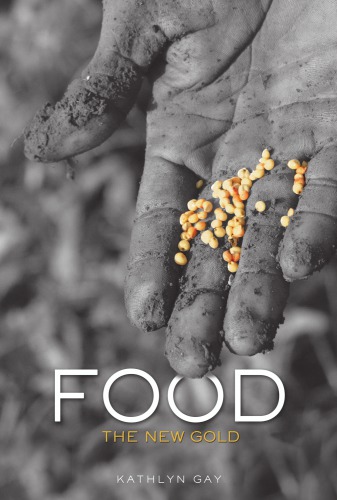
Food
The New Gold
فرمت کتاب
ebook
تاریخ انتشار
2017
Lexile Score
1150
Reading Level
8-9
نویسنده
Kathlyn Gayشابک
9781467701457
کتاب های مرتبط
- اطلاعات
- نقد و بررسی
- دیدگاه کاربران
نقد و بررسی

September 1, 2012
Gr 9 Up-World hunger is not a new issue, but a heightened awareness of what we eat, how it is produced, where it comes from, and why people around the globe are still dying of starvation in this time of apparent plenty is garnering more and more attention all the time. Gay presents a solid introduction to the science, politics, and social concerns surrounding food and its production. Myriad issues are discussed, including such current topics as genetically modified foods, seed saving, agribusiness, and many, many more that affect individuals looking to eat more conscientiously as well as those trying to eradicate global hunger. The subjects are presented in a fairly balanced manner, with sources from both sides of the more controversial issues quoted and noted, though chapter titles such as "Frankenfoods" and "Industrial Farming: Hazardous to Your Health?" provide a glimpse at the author's leanings. Sidebars of slightly tangential, yet equally intriguing, topics, such as the Green Revolution or food recycling, supplement the primary discussion of world hunger. Photographs and diagrams are informative, and the end matter is extremely useful, especially the further-reading suggestions. Though all are likely to agree that world hunger is a problem that needs solving, there is little agreement on the best methods for reaching that solution; this title provides an accessible, up-to-date primer for interested readers.-Jody Kopple, Shady Hill School, Cambridge, MA
Copyright 2012 School Library Journal, LLC Used with permission.

Starred review from September 15, 2012
An intelligent examination of food that probes how it is produced, procured and delivered to consumers--or not. While many Americans and citizens of other wealthy nations take food for granted because of its abundance and availability in seemingly endless variety year-round, millions elsewhere, even in the United States, fare terribly. Gay explores the topic of food as a commodity in a way young readers have perhaps never encountered. Writing with skill, clarity and a finely tuned sense of fairness on all sides of issues, she conveys what a complicated business getting food to the table is. The word business is not to be underestimated, as today's food culture involves multinational corporations in addition to governments and politics, science and technology, and the environment and global warming. Excellent color photographs and illuminating, easy-to-understand charts and diagrams enhance readers' comprehension. Some of this may be difficult to digest: Descriptions of the treatment of food animals before and after slaughter and the handling of industrial waste might turn some stomachs; photos of starving youngsters are heart-wrenching. Yet the outlook isn't completely dire. Gay points to optimistic news, such as the sustainable-agriculture movement, for example. Documentation is sound, though the bibliography offers few child-friendly titles--which perhaps speaks to this book's singularity. A sobering, thought-provoking discussion that provides, yes, much food for thought. (glossary, source notes, bibliography, websites, index) (Nonfiction. 12 & up)
COPYRIGHT(2012) Kirkus Reviews, ALL RIGHTS RESERVED.

Starred review from December 1, 2012
Grades 8-12 *Starred Review* An eye-catching jacket photo leads to a well-researched presentation of worldwide issues related to food. Chapters explore global and American hunger, the shift from family farms to corporate farming, the dangers of industrial farming, the effects of climate change on agriculture, the health risks of genetically engineered plants and animals, issues of food safety, the clash between public health and agricultural interests, and food policy for the future. While an entire book could be devoted to each topic, Gay does a fine job of presenting information on key issues along with specific examples that make them meaningful. Sidebars present topics such as food recycling and city dwellers keeping chickens. Though the chapter title Frankenfoods indicates a certain perspective on genetically engineered foodstuffs, Gay reports the point of view of agribusiness as well as the concerns of consumers, farmers, governments, and environmental groups. Clear color photos take readers to locations as diverse as a Colorado meatpacking plant, a Kenyan maize field, and the White House organic garden. Colorful graphics include a world map indicating relative hunger levels in different countries and a chart showing household incomes and the percentage spent on food in seven nations. An informative, well-documented resource on a timely topic.(Reprinted with permission of Booklist, copyright 2012, American Library Association.)

























دیدگاه کاربران